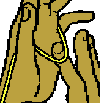|
NEW
ZEALAND
WAI*ATA |
Purerehua Dr. Hirini Melbourne 1975 |
|---|
Kiwi Songs - Maori Songs - Home
|
"I
wrote this song for my daughter whom I
hope
one day will grow up to be a beautiful free butterfly."
|
|
Pūrerehua rere runga e Papaki kau ana Rere runga e |
butterfly drifting on the wind fluttering along all alone flying on the wind |
| Use
a piece of fishing cord about 1.8 metres long
and tie it in a loop.
1. Pick up one short section of the string loop on both thumbs without twisting it. Extend hands apart. |
 |
| 2.
Now, using your little fingers, pick up the
far thumb string on the fingernail side of the
little fingers.
Then just spread your hands and figers apart to tighten the string (Position 1) |

|
|
3. Use your right forefinger to move left and pick up the left palm string on the back of the forefinger. Tighten the strings. |

|
| 4. The left forefinger then moves right, goes through the right forefinger noose, and picks up the right palm string. | 
|
| 5. Tighten the strings again. | 
|
| 6.
Release the thumb strings. Tighten the other
strings once more.
Here is your butterfly. Move your index fingers in and out to make it flutter. |
 |
Other Whai
Maori string games, whai, date back to pre-European times. They are similar to string games played around the world.
Whai was played by both male and female of all ages, although traditionally women were the more proficient.
Whai gave excellent training for the skills needed in activities like weaving, net-making, and thatching.
Waiata (or karakia) were sung (or chanted) to make it easier to remember the pattern-making sequences.
It is said that whai was passed down by Maui. Whai patterns often represented figures from mythology, and so they acted as aids for remembering and illustrating mythological stories.
More Maori string games are described, very clearly and well, in Chapter 8 of Alan Armstrong, "Maori Games and Hakas," AH & AW Reed, (1964). This old book is a real taonga. I found it in the Whanganui District library stackroom. Try your local library, or the National Library in Wellington could photocopy a few pages for you, or you could get it on interloan.
More international string games for kids are at Busy Bee
Bullroarer
Pūrerehua is one example of taonga puoru, the mystical sounding wind instruments of the old Maori people. The emotions of love, passion and grief are woven together in taonga puoru: the sound of the breath of wind is also the sound of the breath of life.
Traditionally pūrerehua were made of hard wood like matai, or whale bone, or of pounamu stone. The plaited cord was made of muka. It whirring roar warned hearers -
| Kia
hiwara kia mataara kia tupato |
Be alert be prepared be careful |
Kiwi Songs - Maori Songs - Home
Page
published on web Sept 1st 2002.
Modified for narrow screens Dec 2021
Lyrics corrected (thanks Rory)
Sept 2023


